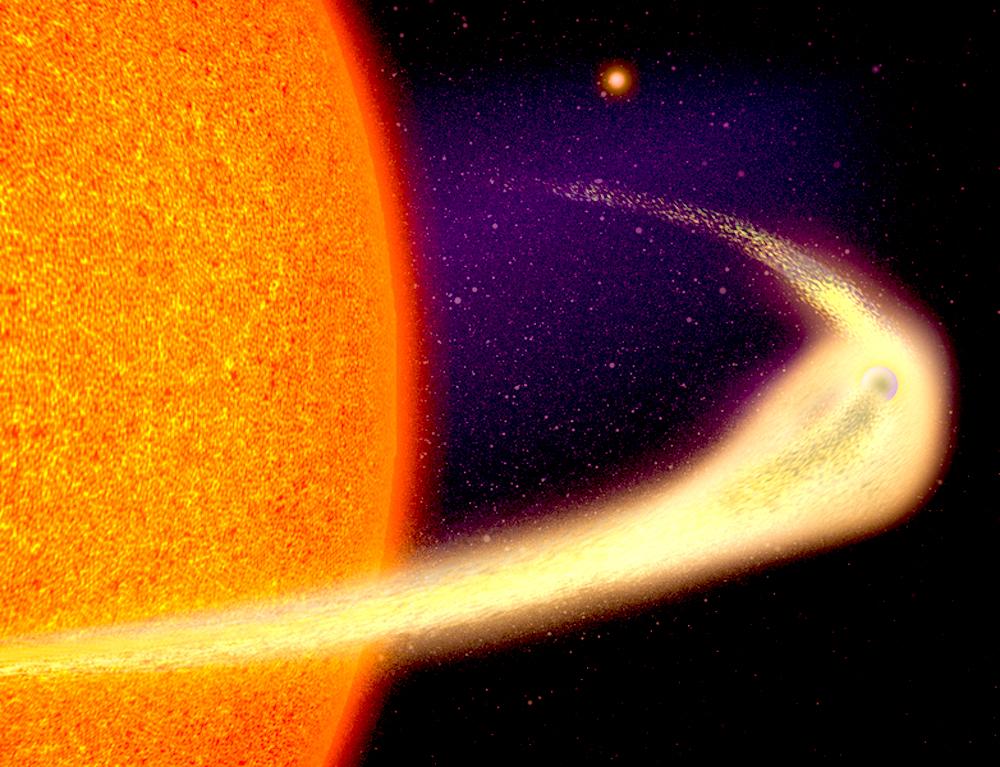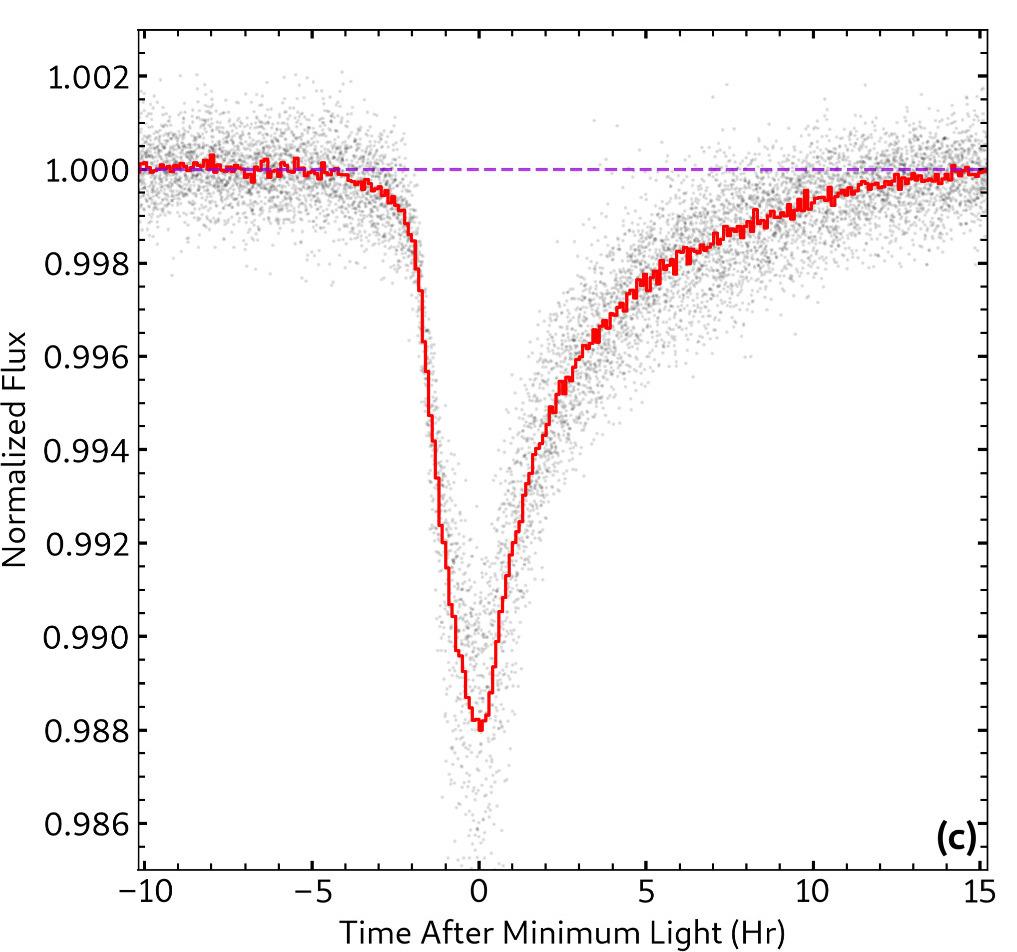Content Warning
These are the most detailed images yet of new solar systems being born.
https://public.nrao.edu/news/exoalma/ #space #science #tech #nature
Content Warning
These are the most detailed images yet of new solar systems being born.
https://public.nrao.edu/news/exoalma/ #space #science #tech #nature
Content Warning
Content Warning
Content Warning
Content Warning
General relativity, also known as the general theory of relativity, and as Einstein's theory of gravity, is the geometric theory of gravitation published by Albert Einstein in 1915 and is the current description of gravitation in modern physics. General relativity generalizes special relativity and refines Newton's law of universal gravitation, providing a unified description of gravity as a geometric property of space and time, or four-dimensional spacetime. In particular, the curvature of spacetime is directly related to the energy and momentum of whatever is present, including matter and radiation. The relation is specified by the Einstein field equations, a system of second-order partial differential equations.
Newton's law of universal gravitation, which describes classical gravity, can be seen as a prediction of general relativity for the almost flat spacetime geometry around stationary mass distributions. Some predictions of general relativity, however, are beyond Newton's law of universal gravitation in classical physics. These predictions concern the passage of time, the geometry of space, the motion of bodies in free fall, and the propagation of light, and include gravitational time dilation, gravitational lensing, the gravitational redshift of light, the Shapiro time delay and singularities/black holes. So far, all tests of general relativity have been shown to be in agreement with the theory. The time-dependent solutions of general relativity enable us to talk about the history of the universe and have provided the modern framework for cosmology, thus leading to the discovery of the Big Bang and cosmic microwave background radiation. ..
>> https://en.wikipedia.org/wiki/General_relativity
* relatively related:
https://en.wikipedia.org/wiki/Kerr_metric
https://en.wikipedia.org/wiki/Penrose_process
https://physicsopenlab.org/2017/09/07/spectral-lines-broadening/
* Credits: Wikimedia Commons
Content Warning
Explanation:
If one black hole looks strange, what about two? Light rays from accretion disks around a pair of orbiting supermassive black holes make their way through the warped space-time produced by extreme gravity in this detailed computer visualization. The simulated accretion disks have been given different false color schemes, red for the disk surrounding a 200-million-solar-mass black hole, and blue for the disk surrounding a 100-million-solar-mass black hole. For these masses, though, both accretion disks would actually emit most of their light in the ultraviolet. The video allows us to see both sides of each black hole at the same time. Red and blue light originating from both black holes can be seen in the innermost ring of light, called the photon sphere, near their event horizons. In the past decade, gravitational waves from black hole collisions have actually been detected, although the coalescence of supermassive black holes remains undiscovered.
https://www.nasa.gov/universe/new-nasa-visualization-probes-the-light-bending-dance-of-binary-black-holes/
https://apod.nasa.gov/apod/ap200825.html
https://en.wikipedia.org/wiki/Accretion_disk
https://apod.nasa.gov/apod/ap190411.html
https://svs.gsfc.nasa.gov/14132/
https://ui.adsabs.harvard.edu/abs/1993AmJPh..61..619N/abstract
https://apod.nasa.gov/htmltest/rjn_bht.html
https://en.wikipedia.org/wiki/Photon_sphere
https://apod.nasa.gov/apod/ap201104.html
https://apod.nasa.gov/apod/ap250506.html
#space #blackhole #astrophotography #photography #astronomy #science #nature#NASA#ESA
Explanation:
How do black holes create X-rays? Answering this long-standing question was significantly advanced recently with data taken by NASA’s IXPE satellite. X-rays cannot exit a black hole, but they can be created in the energetic environment nearby, in particular by a jet of particles moving outward. By observing X-ray light arriving from near the supermassive black hole at the center of galaxy BL Lac, called a blazar, it was discovered that these X-rays lacked significant polarization, which is expected when created more by energetic electrons than protons. In the featured artistic illustration, a powerful jet is depicted emanating from an orange-colored accretion disk circling the black hole. Understanding highly energetic processes across the universe helps humanity to understand similar processes that occur on or near our Earth.
https://www.nasa.gov/missions/ixpe/nasas-ixpe-reveals-x-ray-generating-particles-in-black-hole-jets/
https://apod.nasa.gov/apod/ap031128.html
https://apod.nasa.gov/apod/ap240507.html
https://apod.nasa.gov/apod/ap250504.html
https://en.wikipedia.org/wiki/Blazar
https://en.wikipedia.org/wiki/Polarization_(waves)
https://en.wikipedia.org/wiki/BL_Lacertae
https://home.cern/science/physics
https://ui.adsabs.harvard.edu/abs/2025arXiv250501832A/abstract
https://science.nasa.gov/ems/11_xrays/
https://pwg.gsfc.nasa.gov/Education/whelect.html
https://home.cern/news/news/physics/proton-century
https://chandra.si.edu/art/xray/
https://spaceplace.nasa.gov/aurora/en/
https://apod.nasa.gov/apod/ap250509.html
#space #blackhole #astroart #astronomy #physics #photography #science #nature#NASA
Content Warning
Explanation:
What would it look like to orbit a black hole? Many black holes are surrounded by swirling pools of gas known as accretion disks. These disks can be extremely hot, and much of the orbiting gas will eventually fall through the black hole's event horizon -- where it will never be seen again. The featured animation is an artist's rendering of the curious disk spiraling around the supermassive black hole at the center of spiral galaxy NGC 3147. Gas at the inner edge of this disk is so close to the black hole that it moves unusually fast -- at 10 percent of the speed of light. Gas this fast shows relativistic beaming, making the side of the disk heading toward us appear significantly brighter than the side moving away. The animation is based on images of NGC 3147 made recently with the Hubble Space Telescope.
!>> https://apod.nasa.gov/apod/ap190820.html
As our viewpoint rotates around the black hole, we see different parts of the fast-moving gas in the accretion disk moving directly toward us. Due to a phenomenon called "relativistic Doppler beaming," gas in the disk that's moving toward us makes that side of the disk appear brighter, the opposite side darker. This effect disappears when we're directly above or below the disk because, from that angle, none of the gas is moving directly toward us.
When our viewpoint passes beneath the disk, it looks like the gas is moving in the opposite direction. This is no different that viewing a clock from behind, which would make it look like the hands are moving counter-clockwise.
CORRECTION: In earlier versions of the 360-degree movies on this page, these important effects were not apparent. This was due to a minor mistake in orienting the camera relative to the disk. The fact that it was not initially discovered by the NASA scientist who made the movie reflects just how bizarre and counter-intuitive black holes can be!
Credit: NASA’s Goddard Space Flight Center
Jeremy Schnittman (NASA/GSFC)
Scott Wiessinger (USRA)
Francis Reddy (University of Maryland College Park)
Francis Reddy (University of Maryland College Park)
>>https://svs.gsfc.nasa.gov/13326#section_credits
#space #blackhole #astrophysics #astrophotography #photography #astronomy #science #nature#NASA#ESA
Content Warning
Explanation:
How do black holes create X-rays? Answering this long-standing question was significantly advanced recently with data taken by NASA’s IXPE satellite. X-rays cannot exit a black hole, but they can be created in the energetic environment nearby, in particular by a jet of particles moving outward. By observing X-ray light arriving from near the supermassive black hole at the center of galaxy BL Lac, called a blazar, it was discovered that these X-rays lacked significant polarization, which is expected when created more by energetic electrons than protons. In the featured artistic illustration, a powerful jet is depicted emanating from an orange-colored accretion disk circling the black hole. Understanding highly energetic processes across the universe helps humanity to understand similar processes that occur on or near our Earth.
https://www.nasa.gov/missions/ixpe/nasas-ixpe-reveals-x-ray-generating-particles-in-black-hole-jets/
https://apod.nasa.gov/apod/ap031128.html
https://apod.nasa.gov/apod/ap240507.html
https://apod.nasa.gov/apod/ap250504.html
https://en.wikipedia.org/wiki/Blazar
https://en.wikipedia.org/wiki/Polarization_(waves)
https://en.wikipedia.org/wiki/BL_Lacertae
https://home.cern/science/physics
https://ui.adsabs.harvard.edu/abs/2025arXiv250501832A/abstract
https://science.nasa.gov/ems/11_xrays/
https://pwg.gsfc.nasa.gov/Education/whelect.html
https://home.cern/news/news/physics/proton-century
https://chandra.si.edu/art/xray/
https://spaceplace.nasa.gov/aurora/en/
https://apod.nasa.gov/apod/ap250509.html
#space #blackhole #astroart #astronomy #physics #photography #science #nature#NASA
Content Warning
Credit: NASA’s Goddard Space Flight Center
Jeremy Schnittman (NASA/GSFC)
Scott Wiessinger (USRA)
Francis Reddy (University of Maryland College Park)
Francis Reddy (University of Maryland College Park)
This new visualization of a black hole illustrates how its gravity distorts our view, warping its surroundings as if seen in a carnival mirror. The visualization simulates the appearance of a black hole where infalling matter has collected into a thin, hot structure called an accretion disk. The black hole’s extreme gravity skews light emitted by different regions of the disk, producing the misshapen appearance.
Bright knots constantly form and dissipate in the disk as magnetic fields wind and twist through the churning gas. Nearest the black hole, the gas orbits at close to the speed of light, while the outer portions spin a bit more slowly. This difference stretches and shears the bright knots, producing light and dark lanes in the disk.
Viewed from the side, the disk looks brighter on the left than it does on the right. Glowing gas on the left side of the disk moves toward us so fast that the effects of Einstein’s relativity give it a boost in brightness; the opposite happens on the right side, where gas moving away us becomes slightly dimmer. This asymmetry disappears when we see the disk exactly face on because, from that perspective, none of the material is moving along our line of sight.
Closest to the black hole, the gravitational light-bending becomes so excessive that we can see the underside of the disk as a bright ring of light seemingly outlining the black hole. This so-called “photon ring” is composed of multiple rings, which grow progressively fainter and thinner, from light that has circled the black hole two, three, or even more times before escaping to reach our eyes. ...
>> https://svs.gsfc.nasa.gov/13326
#space #blackhole #astrophotography #astrophysics #photography #astronomy #science #nature#NASA
Content Warning
As our viewpoint rotates around the black hole, we see different parts of the fast-moving gas in the accretion disk moving directly toward us. Due to a phenomenon called "relativistic Doppler beaming," gas in the disk that's moving toward us makes that side of the disk appear brighter, the opposite side darker. This effect disappears when we're directly above or below the disk because, from that angle, none of the gas is moving directly toward us.
When our viewpoint passes beneath the disk, it looks like the gas is moving in the opposite direction. This is no different that viewing a clock from behind, which would make it look like the hands are moving counter-clockwise.
CORRECTION: In earlier versions of the 360-degree movies on this page, these important effects were not apparent. This was due to a minor mistake in orienting the camera relative to the disk. The fact that it was not initially discovered by the NASA scientist who made the movie reflects just how bizarre and counter-intuitive black holes can be!
Credit: NASA’s Goddard Space Flight Center
Jeremy Schnittman (NASA/GSFC)
Scott Wiessinger (USRA)
Francis Reddy (University of Maryland College Park)
Francis Reddy (University of Maryland College Park)
>>https://svs.gsfc.nasa.gov/13326#section_credits
#space #blackhole #astrophysics #astrophotography #photography #astronomy #science #nature#NASA#ESA


Content Warning
African Space Agency takes flight
https://www.universetoday.com/articles/african-space-agency-takes-flight
Content Warning
Content Warning
Content Warning
#Mars Apr. 11, 2025 (Sol 1472)
Credits images: NASA/JPL-Caltech/ASU
#Perseverance #rover#Sol1472#PerseveranceRover#Mars2020 #space#astrodon #science#STEM #geology#WitchHazelHill#NorthernRimCampaign #photography#Stereo3D#3D #stereoscopy #solarocks
Content Warning
Content Warning
Content Warning
Content Warning
We can study the inner structure of a dying planet, 140 light years from Earth, as it is peeled away by its star, layer by layer.
https://news.mit.edu/2025/astronomers-discover-planet-thats-rapidly-disintegrating-producing-comet-tail-0422 #space #science #death


Content Warning
Curiosity Rover Wheel Check - Curiosity acquired this image using its Mars Hand Lens Imager (MAHLI), located on the turret at the end of the rover's robotic arm, on April 22, 2025, Sol 4518 of the Mars Science Laboratory Mission
Credits: NASA/JPL-Caltech/MSSS
#CuriosityRover#MSL#MarsRover#NASA#Science#Space#Exploration#Solarocks#Mars #MAHLI#WheelOfTime
Content Warning